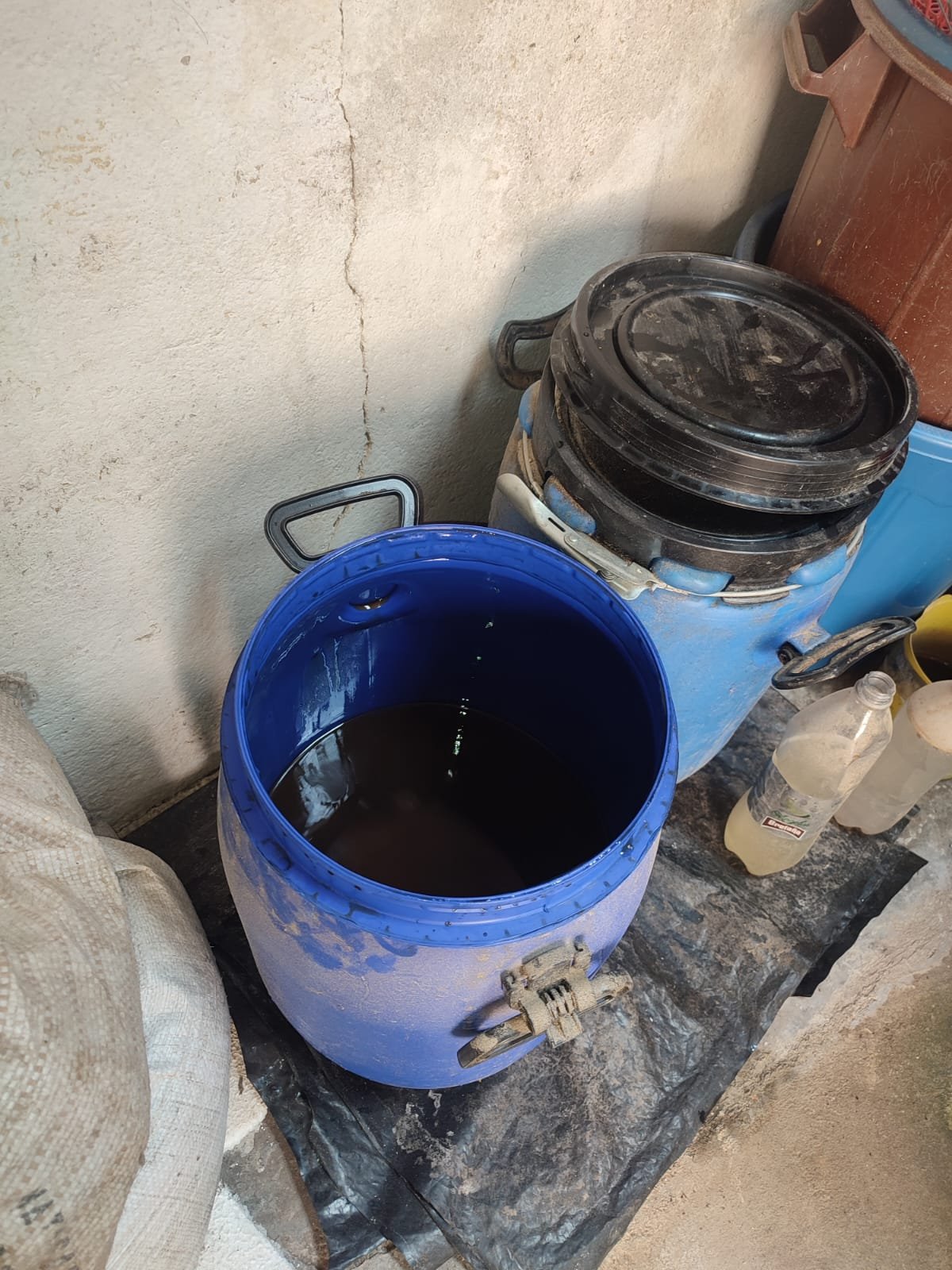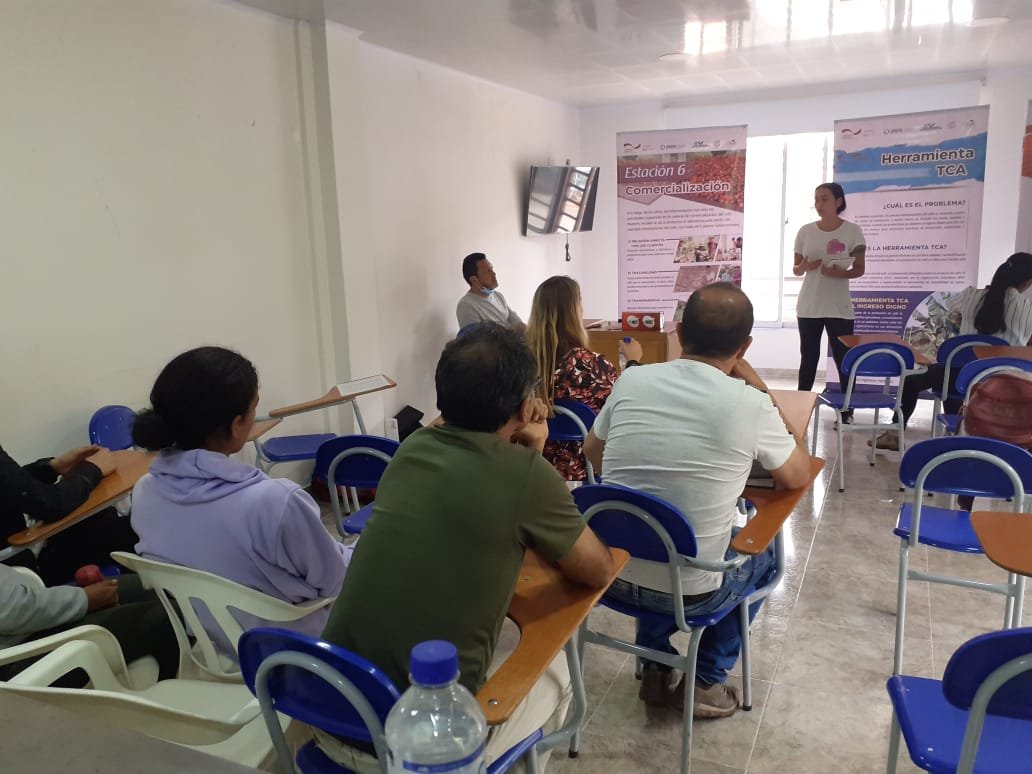the challenge
To create a physical space for farmers in Nariño and surrounding vicinities to share the regenerative, digital, and administrative knowledge that will eventually lead them to offer organic coffee to the international market in a transparent and traceable way. Considering that Colombia is today the largest cocaine production country in the world, followed by Perú and Bolivia, special attention is given to illicit crop farmers seeking an alternative through coffee.
WHERE: Nariño, Córdoba, Colombia
WHAT: Construction of a training center for farmers to gather, share information, learn about organic farming practices and support the reconstruction of the damaged soil in the area.
WHO: Argote Specialty Coffee, This Side Up, MVO and GIZ
GOALS:
The contributions were invested in:
To build the training facility that allows farmers in Nariño and surrounding vicinities to learn about sustainability, biofertilization, and the use of the digital tools that can eventually lead them to commercialize their coffee in a transparent, sustainable, and traceable way, adapted to the current specialty coffee market.
To inspire farmers (who for social or political reasons work on illicit crops or have never worked for coffee before) to have a place where they can find assistance and information regarding the long-term benefits of coffee.
To promote sustainable practices, soil health, regenerative practices and bio fertilisation in Nariño and, eventually, in other regions in Colombia.
To remove scepsis surrounding bio fertilisations such as: "bio fertilisers are low quality," "trees don't assimilate biofertilisers,"; " trees can die."
To promote gender equality in the region: extra attention will be given to providing equal opportunities to women in the Argote Training Center.
The hiring of a full time manager, two part-time managers and a part-time administrative staff.
Development of a training concept as part of business plan and assistance in financial independence of the hub.
Trainings workshops for farmers on organic fertilizer, measuring soil quality, agroforestry, quality control, financial literacy to be able to make good contracts, promotion material and TCA tool.
QC coffees using new fertiliser / agroforestry pilot plot
* Roasting samples
* Developing roasting profiles
* Developing cupping profiles
* Green gradingIdentification of involvement of surrounding communities/ Preparation of the expansion of relations to neighbouring village.
Train the trainers program.
Promoting the centre in other regions.
Establishing mechanisms for ther provision of TCA tool to farmers.
Market access and commitment of private partners in Europe.
PROJECT
timeline
The development of this project and its main achievements, through time.
land identification
January 2020
By Juan Pablo Lasso Argote
Strategically located next to a plot with 2,600 coffee trees, Juan Pablo and his team clean the land where the training hub will stand.
construction Begins
September 2020
Argote, MVO, TSU, GIZ
A local architect is hired to create a self-sufficient and sustainable training facility. The biofertiliser is tested in the demonstration plot monthly (foliar and in the roots) in around 2,600 coffee trees. The vegetable plot is designed.
developing teaching materials
September 2020
By MVO, TSU, GIZ
Baseline materials are developed, printed on a large scale, and installed throughout the Training Hub route. Experienced farmers share their knowledge supported by these tools; they gain confidence as knowledge givers and create conversations with a younger generation of farmers and students.
the construction concludes
April 2021
The center is ready to open its doors. No official inauguration is held, but students from a local school are invited to the first route. The school, The Training Center, and Argote, create a relationship, hoping to support the coffee knowledge of the younger generations.
DemoNstration plot first visible results
TSU, GIZ, Argote
Sept. 2021
After a year of only applying biofertilisers in the demonstration plot, the first visible results come to life. A few farmers close to Juan Pablo become curious: they ask about the product to buy or make themselves.
trainers attend the first training hub class
Argote, TSU, GIZ and MVO
November 21-March 22
Twelve capacitors gather for the first class. The sessions include biofertilisers (how to make them, why use them); international affairs (exportation procedures and paperwork, contract signing). At a fundamental level, the TCA use and purpose are taught: why is it essential to estimate the true cost of coffee?
“In coffee everything is long-term. We do something now and expect to see it blossom in two or three years.”
unexpected results
&
Future steps
This project helped systematise knowledge that was, until then, only spoken. By offering a space to older farmers to share their knowledge, and by developing the materials that gather their wisdom and experience, farmers became teachers and recognized, in the process, the value of their own knowledge. Many farmers in this project realised they could communicate what they know simply and clearly, inspiring, with this, conversations between farmers, students, and young people in the village.
This project brought together three very unique and different entities: GIZ, TSU and MVO.
The local elementary school and the Training Hub created a partnership that aims to inspire younger generations to seek coffee as a way of living.
In the near future, the Training Center will find strategies to stay active throughout the year, and with a wider array of activities. So far, farmers have participates when it’s off-season. What sort of activities can be offered in the center when farmers are busy? A question Juan Pablo is seeking to answer soon.
To become the learning center that attracts young people from the village.
To position the center regionally and nationally. To find alternative channels to spread the knowledge produced in the center and by the farmers that participate in it.
“This center opens the possibility of changing our mindset on organic agriculture and its relationship with the rebirth of our ecosystem. ”
Background
TCA, the tool to discover hidden real costs.
True Cost Accounting is the tool designed by MVO that seeks to account for the real costs of coffee. This tool maps the hidden costs of coffee production. What is the impact of producing coffee on the soil, the water, and biodiversity? During three weeks, and as the Training Hub opened its doors, MVO agents traveled to Colombia to test the functionality of this tool. During this time, they offered a workshop for the farmers in the Hub explaining at large the relevance of this tool in today's coffee market. "This tool is useful because it helps us identify the total expenses invested in our lands. It also helps us understand and control the farmers' necessities better." Shared Verónica Lasso, project coordinator in Argote Specialty Coffee.
TCA digital tool
Spreading Organic Fertilization in the Nariño area and surrounding vicinities
Monoculture practices installed in South America over the last century came hand in hand with a widespread chemical fertilizers campaign that, sadly, farmers from the previous generation acquired and believed to be the best, leaving their traditional, more economical, and biodegradable practices behind. No better example to reflect this than the Argote family. When Juan Pablo (son) found his grandfather's notes on biofertilizers after he passed away, he immediately showed them to his father. He had been trying to convince his father about the benefits of switching to organic fertilization for a long time. His father, however, resisted. He didn't trust they would work. He was worried trees would die. He didn't want to lose his time. This was the proof Juan Pablo needed, coming from his late grandfather. How could his father refuse?
This was the start of the bio-fertilizers project and its subsequent hub. The project began with a curiosity to try something new and developed into a hub that aims to attract farmers from the area. Recently, Juan Pablo shared the recipe for the fertilizers he makes. "The idea is that everyone uses what's at hand in their own land," he said.
Alternative Development and IlLicit Crops Cultivation in Nariño.
(with information created by GIZ)
Colombia plays a crucial role in the global drug economy, with the country long being considered the world’s largest coca cultivator. More than 70% of the coca cultivated globally, the essential resource for cocaine production, originates from Colombia (UNODC, 2019).
Most coca bush cultivation continues to take place in the south of the country, with the department of Nariño accounting for more than 27 per cent of the total coca bush cultivation in Colombia (UNODC, 2022). In 2021, coca was illegally grown on 204,000 hectares (UNODC & Colombia, 2020) - mostly by small-scale farmers who are involved in cultivation because of a lack of legal economic alternatives.
The illicit cultivation of coca is directly linked to rural poverty. The lack of development perspectives in these areas has long been held as the root cause of drug crop cultivation. Poor infrastructure in remote drug cultivating areas furthermore impedes the marketing of alternative products. In the absence of viable alternative options of agricultural production, smallholder farmers struggle to secure their livelihoods.
Moreover, the cultivation of drug crops is closely linked to the armed conflict that has been raging in the country for over 60 years.
The cultivation of coca, as well as the subsequent processing of cocaine hydrochloride, causes severe environmental damage in Colombia. In order to process land for drug crops, smallholder farmers routinely clear-cut previously intact forests through the use of slash-and-burn in order to open up areas for plantation (Burns-Edel, 2016: 3). As a matter of fact, the Colombian National Department of Anti-narcotics (Dirección Nacional de Estupefacientes) estimates that it takes up to four hectares of forest in order to cultivate one hectare of coca (DNE, 2006).
Monoculture plantations as well as excessively applied fertilizers and chemicals further erode the soil. The processing of coca to extract alkaloids - using substances like gasoline, benzene, sulphuric acid, carbide, and sodium carbonate - contaminates not only the soil, but also water. Due to the illegal nature of drug crop cultivation, smallholder farmers often make little effort in soil conservation and sustainability practices as evidenced by the high mobility and short life of coca plots (UNODC, 2006).
The Alternative Development approach relies on the understanding that drug crop growing areas are mostly rural areas where isolation and poverty are inherent and where farmers cultivate illicit drug crops because they are unable to obtain sufficient income from legal activities due to conflict, marginalization, lack of access to land and legal markets, and the absence of basic infrastructure.
Biofertiliser recipe
These are some elements that can be added to the fertilizer: phosphoric rock, ammonium sulphate, borax and zinc sulphate.
2. Start with molasses and milk.
3. Add the required element (as described on the recipe*) with ash and rock.
4. Add this mixture to the L Plastic Tank where the fertilizer base (in this case, its cow and guinea pig excrement) is stored; and add rainwater.
5. Once the fertilizer is ready, store in L Plastic Tanks.
6. Mix and allow it to ferment for around 40 days.
7. Mix 2 liters of fertilizer, 9 liters of rainwater, and 9 liters of activated microorganisms.
Activated microrganisms? here is How to prepare them.
Collect dry leaves that show the presence of microorganisms (white spots).
2. Store them in L Plastic Tank with other elements, so they reproduce and stay in a “latent” state. Make sure they stay dry.
3. Activate microorganisms with rainwater, molasses, and milk two weeks before the fertilization campaign begins.
4. Rainwater is essential because it's chlorine-free (chlorine kills microorganisms).
Project images:
Feel free to use when supporting this initiative.

















































































